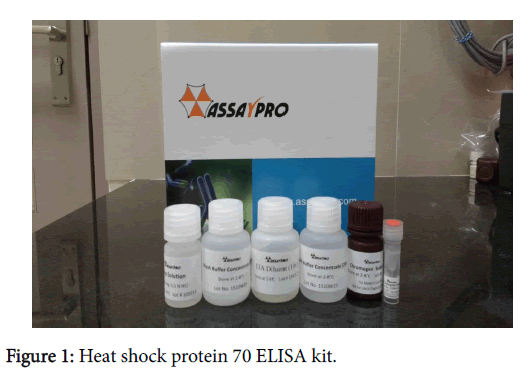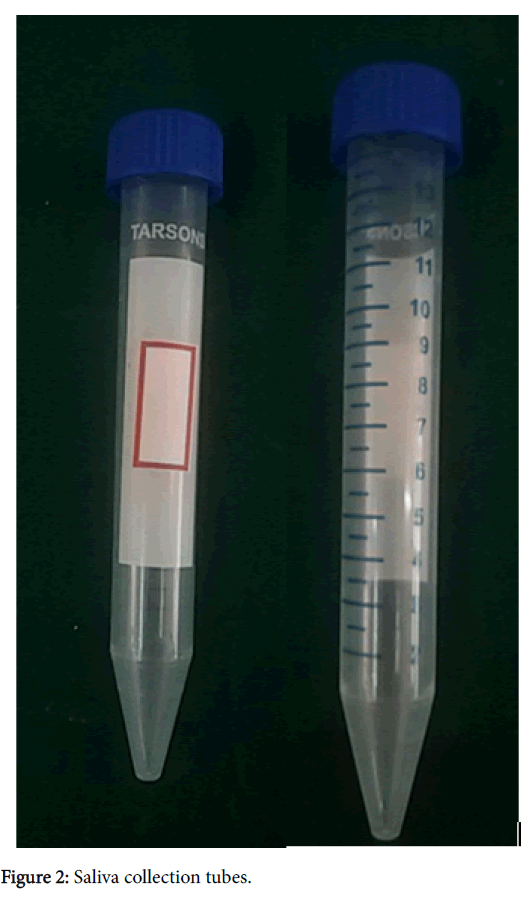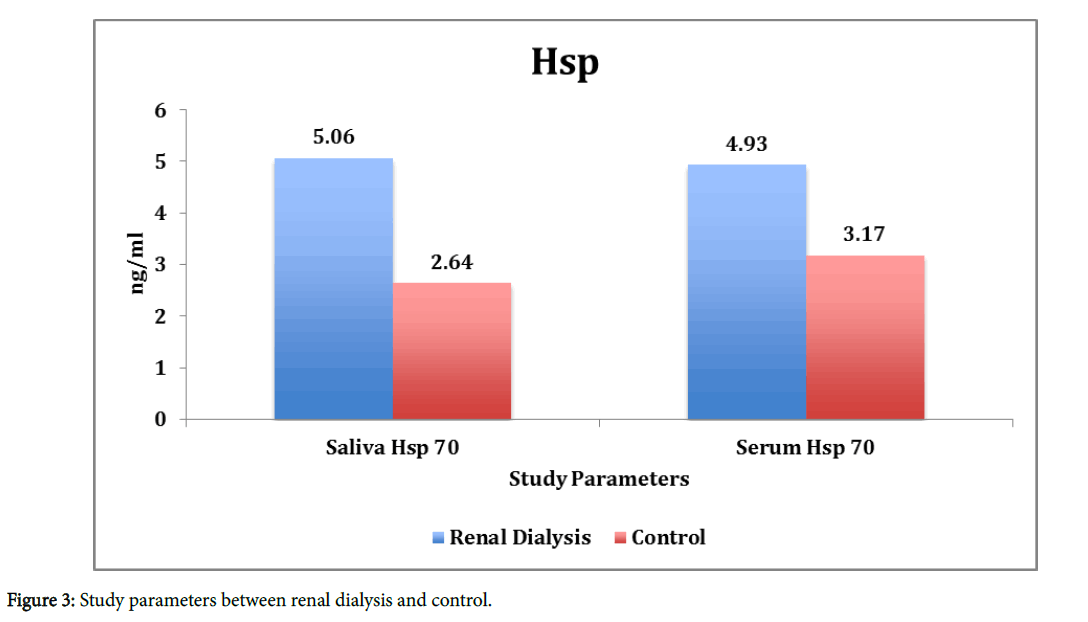Research Article Open Access
Saliva as a Biomarker of Heat Shock Protein in Chronic Renal Disease
Mithra N Hegde1, Nireeksha2* and Shilpa Shetty3
1Department of Conservative Dentistry and Endodontics, A. B. Shetty Memorial Institute of Dental Sciences, India
2Department of Conservative Dentistry and Endodontics, A. B. Shetty Memorial Institute of Dental Sciences, India
3Central Research Laboratory, Nitte University, India
- *Corresponding Author:
- Nireeksha
Post Graduate Student, Department of Conservative Dentistry and Endodontics
A. B. Shetty Memorial Institute of Dental Sciences
Mangalore, India
Tel: 9739755940
E-mail: nireekshashetty24@gmail.com
Received Date: March 24, 2016; Accepted Date: April 22, 2016; Published Date: April 30, 2016
Citation: Hegde MN, Nireeksha, Shetty S (2016) Saliva as a Biomarker of Heat Shock Protein in Chronic Renal Disease. J Interdiscipl Med Dent Sci 4:195. doi: 10.4172/2376-032X.1000195
Copyright: © 2016 Hedge MN, et al. This is an open-access article distributed under the terms of the Creative Commons Attribution License, which permits unrestricted use, distribution, and reproduction in any medium, provided the original author and source are credited.
Visit for more related articles at JBR Journal of Interdisciplinary Medicine and Dental Science
Abstract
Background and Objective: Heat shock protein 70 usually located in the cytoplasm, it plays an important role has a chaperone. It said to have anti- proinflammatory effect, as shown in experimental model. These play an extended role in immunity and implication in pathogenesis of systemic conditions. In chronic renal kidney disease the complexity of underlying disturbances is an ideal example for persistent multifactorial stress. The combination of uremic toxins, mediators of inflammation, oxygen species, apoptosis and renal dialysis. The role of heat shock proteins in chronic renal damage, their protective and deleterious effect is of prime importance for the future perspectives of optimizing renal therapy the aim of this study was to evaluate the circulatory and salivary heat shock protein level 70 in healthy individuals and individuals undergoing renal dialysis with chronic renal disease.
Method: 40 patients attending to the department of nephrology, K. S. Hegde Medical hospital diagnosed with chronic renal disease, undergoing renal dialysis in the age group of 35-60 yrs were included in the study. Individuals with other active infections, pregnant and lactating women’s, smokers were excluded from the study. The study was conducted among Control (n = 40) and Experimental group (n = 40). Saliva and serum samples were evaluated for Heat shock protein 70 by ELIZA Method (Enzyme -linked immunoassay for heat shock protein 70) and statistical analysis was done with independent student‘t’ test. P < 0.05 was considered to be statistically significant.
Conclusion: Salivary and circulatory Heat Shock protein 70 showed significant increase in Individuals undergoing renal dialysis .Thus, Circulatory and salivary Heat Shock Protein 70 is an efficient stress marker in chronic renal disease condition.
Keywords
Heat shock protein; Renal dialysis; Stress response
Introduction
The presence of a specific group of proteins in the fruitfly Drosophilia melanogaster as a response to high temperature first identified by Ritossa in 1962 then termed as heat shock protein, have been an area of interest with context to their biochemical and functional role, change in cellular changes during disease, aging and infectious process [1].
Various stressful conditions like sudden temperature increase that may damage the cellular structure and their essential functions, under which organisms should survive. As a response to stress ancient signalling pathway leads to expression of heat shock proteins, they have an efficient protective mechanism, preventing a non -specific protein aggregate [2]. Heat Shock protein 70 is one of those molecular chaperons which are highly concerned, involved in DE novo folding of proteins also in stressful conditions prevent the aggregation of unfolding proteins and even refold [3].
Heat shock proteins 70 protects cells against oxidative stress inhibits stress kinase and apoptosis [4]. In oral disorders, these heat shock proteins are increased due to chronic irritation, infection, long time irradiation and malignancies. Vaccinations with the modified epitopes bacterial HSP’s 70 and in some cases prevents development of disease [5].
Heat shock protein 70 usually located in the cytoplasm, it plays an important role has a chaperone. It said to have anti- proinflammatory effect, as shown in experimental model. These play an extended role in immunity and implication in pathogenesis of systemic conditions [6]. They even play an important role in defence function on tooth surface, by binding and agglutinating the microbes via salivary complex’s, thus the presence of these HSP’s enhance the protection against heat stress and altering Ph. providing cytoprotective effect and thus aiding in defence [7].
Thus the goal of these chaperons is to regulate the response to any detrimental factors, including temperature, radiation, hypoxia, toxins, preventing misfolding of proteins.
In chronic renal kidney disease the complexity of underlying disturbances is an ideal example for persistent multifactorial stress. The combination of uremic toxins, mediators of inflammation, oxygen species, apoptosis and renal dialysis. The role of heat shock proteins in chronic renal damage, their protective and deleterious effect is of prime importance for the future perspectives of optimizing renal therapy [8].
Thus, the aim of this study was to evaluate the Circulatory and salivary heat shock protein level 70 in healthy individuals and individuals undergoing renal dialysis with chronic renal disease.
Materials and Methods
After obtaining institutional ethical clearance, 40 patients attending to the department of nephrology, K. S. Hegde Medical hospital diagnosed with chronic renal disease, undergoing renal dialysis since 9 months under the age group of 35-60 yrs were included in the study. Individuals with other active infections, pregnant and lactating women’s, smokers were excluded from the study.
The study was conducted among Control (n = 40) and Experimental group (n = 40).
Saliva collection
Salivary collection was done according to the technique by Navazesh 1993 [9]. 3 ml unstimulated was collected in a sterile disposable plastic container and the samples were stored at −70°C and used for further analysis.
Serum preparation
A volume of 3 ml of peripheral blood was drawn from patients using venipuncture from the antecubital fossa. Blood was allowed to clot at room temperature for 30 min and centrifuged at 3000 rpm for 10 min. The obtained serum was then divided into 2 aliquots and then transferred to a labelled poly propylene tube and stored at -70°C and used for further analysis.
Enzyme -linked immunoassay for heat shock protein 70
Enzyme-linked immunosorbent assay kit (Assay Designs and Stressgen) was used. Serum, and saliva samples were analyzed using Elisa system according to the manufacturer’s recommended procedure and 96 well plate precoated with appropriate antibodies was used.
Serum, saliva samples and standards were added and incubated for 3 h. Then, the conjugate antibody was added and incubated 1 h at room temperature. The plates were washed again, and substrate was added to develop colour change and incubated for 30 min at room temperature in the dark. Finally, the optical densities were read at 450 nm, and the samples were compared to the standards. The results for HSP 70 were expressed at ng/ml (Figures 1 and 2).
Statistical Analysis
Student’s ttest was used for statistical analysis of the circulatory and salivary HSP 70 values healthy individuals and an individual undergoing renal dialysis, which was expressed in terms of mean and standard deviation. P < 0.05 was considered to be statistically significant.
Results
There was a significant increase in Serum Heat shock protein 70 levels in Experimental group (4.936 ng/ml) in comparison with the control group (3.170 ng/ml) (Table 1, Figure 3).
| Hsp 70 (ng/ml) | Groups | N | Mean | SD | Mean difference (95% CI) | t | dff | P-value |
|---|---|---|---|---|---|---|---|---|
| Saliva | Experimental Group | 40 | 5.066 | 0.398 | 2.425 (2.023, 2.827) | 12.67 | 18 | < 0.001* |
| Control | 40 | 2.641 | 0.456 | |||||
| Serum | Experimental Group | 40 | 4.936 | 0.371 | 1.767 (1.369, 2.164) | 9.34 | 18 | < 0.001* |
| Control | 40 | 3.17 | 0.469 |
Table 1: Salivary Heat shock protein 70 shock showed significant levels in experimental levels (5.066 ng/dl) compared to control group (2.641 ng/dl).
Discussion
This study aimed at evaluating whether heat shock protein 70 is an efficient stress marker in chronic kidney disease conditions. Reversing polypeptide unfolding and preventing protein aggregation are major functions of heat shock proteins, especially under stress. In nonstressed cells heat shock proteins are present in low concentrations, while in stressed cells they accumulate in higher levels [11].
The study showed that salivary and serum HSP 70 could be efficient stress markers. Heat shock protein activation seems to be indicator for reactive stressful condition such has blood dialyzer contact [12]. Mao et al., examined rats with obstructive nephropathy and the impact of heat shock protein, the study showed that HSP 72 given orally inhibited proliferation and apoptosis of tubular cells and decreased accumulation of fibroblast and collagen in renal parenchyma showing fibrosis, Lin et al., in 2010 confirmed the cytoprotective role of HSP 27 in atherogenesis in rats undergoing subtotal nephropathy [13].
The role of heat shock proteins in skeletal muscle atrophy typical among patients undergoing haemodialysis was explained by Crowe et al., in (2007) [14]. In cases of Kidney transplantation the stress induced Heat Shock protein 70 expression improved their survival rate in both humans and rats [15].
The intracellular forms of Heat shock proteins show a cytoprotective and anti-apoptotic role in the progression of chronic kidney disease. Dialysis definitely aggravates the disturbances in stress response. Therefore, future investigations should concrete on the mode of heat shock protein induction, and therapeutic interventions improving their general health status.
Acknowlegdement
Central Research Laboratory, Nitte University Mangalore.
Dr. E. Padmini, Associate Professor, Dept.of Biochemistry, Bharathi womens college, Chennai, 6008108 for her support throughout the analysis.
References
- Ritossa F (1962) A new puffing pattern induced by temperature shock and DNP in Drosophila. Experientia 18: 571��?573.
- Richter K, Haslbeck M, Buchner J (2010) The Heat Shock Response: Life on the Verge of Death.Journal of molecular biology 40: 253��?266.
- Mayer MP, Bukau B (2005) Hsp70 chaperones Cellular functions and molecular mechanism. Cell Mol Life Sci 62: 670��?684.
- Gabai VL, Meriin AB, Yaglom JA, Volloch VZ, Sherman MY (1998) Role of Hsp70 in regulation of stress-kinase JNK: implications in apoptosis and aging. FEBS Lett 438: 1��?4.
- Van Eden W, Young DB (1996) Stress Proteins in Medicine. Marcel Dekker, Inc., New York, Basel, Hong Kong.
- Albanidou-Farmaki E, Andreadis D, Poulopoulos A, Farmakis K, Markopoulos A (2014) Serum levels of Heat Shock Protein-70 in Patients with Oral Lichen Planus. Balkan J Dent Med 18: 106��?108.
- F�?¡bi�?¡n TK, G�?³tai L, Beck A, F�?¡bi�?¡n G, Fej�?©rd P (2009) The role of molecular chaperones (hspas/hsp70s) in oral Health and oral inflammatory diseases: a review. European journal of inflammation 7.
- Musial K, Zwolinska D (2011) Heat shock proteins in chronic kidney disease. PediatrNephrol 26: 1031-1037.
- Navazesh M (1993) Methods for Collecting Saliva. Annals of the New York Academy of Sciences 694: 72-77.
- Mao H, Li Z, Zhou Y, Li Z, Zhuang S, et al. (2008) HSP72 attenuates renal tubular cell apoptosis and interstitial fibrosis in obstructive nephropathy. Am J Physiol Renal Physiol 295: 202��?214.
- Becker J, Craig EA (1994) Heat shock proteins as molecular chaperones. Eur J Bioche 219: 11��?23.
- Musial K, Szprynger K, Szczepanska M, Zwolinska D (2009) Heat shock proteins in children and young adults on chronichemodialysis. PediatrNephrol 24: 2029��?2034.
- Lin YP, Hsu ME, Chiou YY, Hsu HY, Tsai HC, et al. (2010) Comparative proteomic analysis of rat aorta in a subtotal nephrectomy model. Proteomics 10: 2429��?2443
- Crowe AV, McArdle A, McArdle F, Patwell DM, Bell GM, et al. (2007) Markers ofoxidative stress in the skeletal muscle of patients on hemodialysis. Nephrol Dial Transplant 22: 1177��?1183.
- Trieb K, Dirnhofer S, Krumbock N, Blahovec H, SgoncR, et al. (2001) Heat shock protein expression in the transplanted human kidney. Transplant Int14: 281��?286.
Relevant Topics
- Cementogenesis
- Coronal Fractures
- Dental Debonding
- Dental Fear
- Dental Implant
- Dental Malocclusion
- Dental Pulp Capping
- Dental Radiography
- Dental Science
- Dental Surgery
- Dental Trauma
- Dentistry
- Emergency Dental Care
- Forensic Dentistry
- Laser Dentistry
- Leukoplakia
- Occlusion
- Oral Cancer
- Oral Precancer
- Osseointegration
- Pulpotomy
- Tooth Replantation
Recommended Journals
Article Tools
Article Usage
- Total views: 12929
- [From(publication date):
June-2016 - Apr 04, 2025] - Breakdown by view type
- HTML page views : 11912
- PDF downloads : 1017



